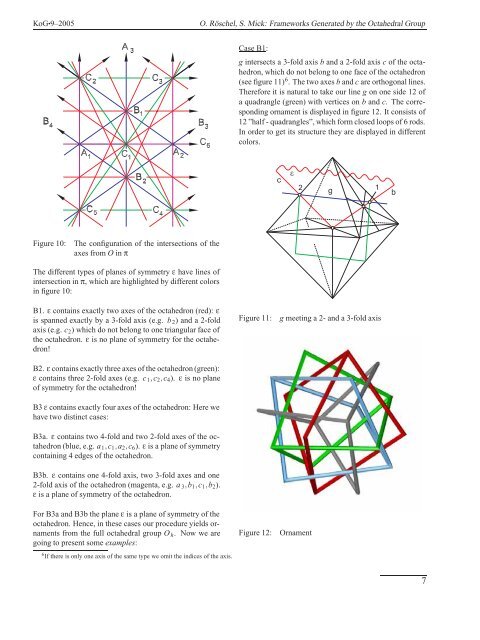Ovaj broj KoG-a u Adobe PDF formatu - hdgg
Ovaj broj KoG-a u Adobe PDF formatu - hdgg
Ovaj broj KoG-a u Adobe PDF formatu - hdgg
You also want an ePaper? Increase the reach of your titles
YUMPU automatically turns print PDFs into web optimized ePapers that Google loves.
<strong>KoG</strong> •9–2005 O. Röschel, S. Mick: Frameworks Generated by the Octahedral Group<br />
Figure 10: The configuration of the intersections of the<br />
axes from O in π<br />
The different types of planes of symmetry ε have lines of<br />
intersection in π, which are highlighted by different colors<br />
in figure 10:<br />
B1. ε contains exactly two axes of the octahedron (red): ε<br />
is spanned exactly by a 3-fold axis (e.g. b 2) and a 2-fold<br />
axis (e.g. c2) which do not belong to one triangular face of<br />
the octahedron. ε is no plane of symmetry for the octahedron!<br />
B2. ε contains exactly three axes of the octahedron (green):<br />
ε contains three 2-fold axes (e.g. c1,c2,c4). ε is no plane<br />
of symmetry for the octahedron!<br />
B3 ε contains exactly four axes of the octahedron: Here we<br />
have two distinct cases:<br />
B3a. ε contains two 4-fold and two 2-fold axes of the octahedron<br />
(blue, e.g. a1,c1,a2,c6). ε is a plane of symmetry<br />
containing 4 edges of the octahedron.<br />
B3b. ε contains one 4-fold axis, two 3-fold axes and one<br />
2-fold axis of the octahedron (magenta, e.g. a 3,b1,c1,b2).<br />
ε is a plane of symmetry of the octahedron.<br />
For B3a and B3b the plane ε is a plane of symmetry of the<br />
octahedron. Hence, in these cases our procedure yields ornaments<br />
from the full octahedral group O h. Now we are<br />
going to present some examples:<br />
6 If there is only one axis of the same type we omit the indices of the axis.<br />
Case B1:<br />
g intersects a 3-fold axis b and a 2-fold axis c of the octahedron,<br />
which do not belong to one face of the octahedron<br />
(see figure 11) 6 . The two axes b and c are orthogonal lines.<br />
Therefore it is natural to take our line g on one side 12 of<br />
a quadrangle (green) with vertices on b and c. The corresponding<br />
ornament is displayed in figure 12. It consists of<br />
12 ”half - quadrangles”, which form closed loops of 6 rods.<br />
In order to get its structure they are displayed in different<br />
colors.<br />
2<br />
Figure 11: g meeting a 2- and a 3-fold axis<br />
Figure 12: Ornament<br />
1<br />
7


